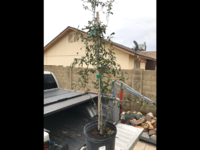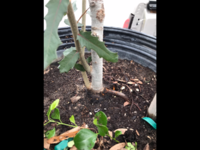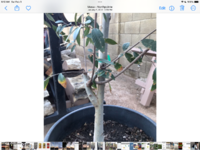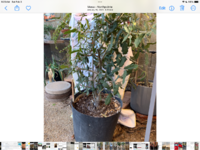The thought struck me this week. I don’t hear much talk of Live Oak bonsai. Does it not do good? I don’t even see small live oak seedlings. I’m in NE Tx area. I drive a LOT are Texas. Any place I could visit for 2-3 seedlings? At least 12”. I’d give my cell #, not sure how to use private messaging here.
You are using an out of date browser. It may not display this or other websites correctly.
You should upgrade or use an alternative browser.
You should upgrade or use an alternative browser.
Live Oak bonsai?
- Thread starter Goodroot
- Start date
Joe Dupre'
Omono
RaginCajun
Mame
Seek out some local yamadori. Texas burr oaks are good. Wish I had one  .
.
Your cedar elms are beasts for bonsai, as well.
Your cedar elms are beasts for bonsai, as well.
RaginCajun
Mame
There is a big nursery somewhere around Tyler I think. Or maybe a little closer to Dallas... They have a website. They sell BIG Japanese black pines, oaks, elms, Texas persimmon.. they have a lot of good material there.
PaulH
Omono
pandacular
Masterpiece
These one look really big when they look (and ARE) really big. Bonsai Texas style should mean LARGE. I agree about looking for one to dig, just cause it’s gonna how you’re going to best nail the bigness.
rockm
Spuds Moyogi
The thought struck me this week. I don’t hear much talk of Live Oak bonsai. Does it not do good? I don’t even see small live oak seedlings. I’m in NE Tx area. I drive a LOT are Texas. Any place I could visit for 2-3 seedlings? At least 12”. I’d give my cell #, not sure how to use private messaging here.
rockm
Spuds Moyogi
If you're in Texas, the live oak sold in nurseries in North and East Texas is probably NOT straight up southern live oak (quercus virginiana). Virginiana is coastal in the S.E. Quercus Fusiformis (escarpment live oak) is an upland species that is more common in Dallas, F.W. over to Tyler and down to Austin. The two species interbreed a lot in Texas. The area around Austin and that latitude in the state are the home of "Hybrid swarms" of cross bred oaks where the two species ranges intermix. The further north you go, fusiformis wins out over Virginiana because of drier, colder conditions. Fusiformis is a more drought and cold hardy live oak relative. It is all over east and north Texas. All those oak trees you see in Dallas and Tyler are fusiformis, not virginiana.
Fusiformis make excellent bonsai, much more so than straight southern live oak, since it is a tougher, more drought and cold tolerant tree. IF you can get decent roots on whatever you've got from a nursery or from the wild they adapt extremely well to bonsai culture. I've had a fusiformis as bonsai for almost 30 years. I've got a lot of family all over Texas and have been going there since I was a small kid, which ingrained live oak in my brain as a 'must have' bonsai subject. My tree was collected from the scrub near Salado. It was originally a 25-30 foot tree and reduced to a stump and dug up by a great pioneering bonsai collector.
FWIW, Don't bother with two or three year old seedlings. Look for larger material. Oak bonsai isn't worth having if it's spindly. Oak is treasured for its old ancient look. That means a substantial trunk. A seedling will take a decade or more of simple growing out to produce a decent trunk. If you're looking in nurseries, look for saplings with more substantial trunks (like over an inch, bigger is better). Fusiformis is cultured in east Texas nurseries from gallon containers up to 500 gallons for landscaping purposes.
Here's mine. The polaroid pics are the tree when I got it. The others are 25 years down the road and in front of the cold greenhouse where I overwinter it.




Fusiformis make excellent bonsai, much more so than straight southern live oak, since it is a tougher, more drought and cold tolerant tree. IF you can get decent roots on whatever you've got from a nursery or from the wild they adapt extremely well to bonsai culture. I've had a fusiformis as bonsai for almost 30 years. I've got a lot of family all over Texas and have been going there since I was a small kid, which ingrained live oak in my brain as a 'must have' bonsai subject. My tree was collected from the scrub near Salado. It was originally a 25-30 foot tree and reduced to a stump and dug up by a great pioneering bonsai collector.
FWIW, Don't bother with two or three year old seedlings. Look for larger material. Oak bonsai isn't worth having if it's spindly. Oak is treasured for its old ancient look. That means a substantial trunk. A seedling will take a decade or more of simple growing out to produce a decent trunk. If you're looking in nurseries, look for saplings with more substantial trunks (like over an inch, bigger is better). Fusiformis is cultured in east Texas nurseries from gallon containers up to 500 gallons for landscaping purposes.
Here's mine. The polaroid pics are the tree when I got it. The others are 25 years down the road and in front of the cold greenhouse where I overwinter it.




Last edited:
Arizona bonsai
Shohin
I have a live oak that I got from Home Depot a few years ago. I chopped it down as it was six feet tall. The next year I pulled it from the 5 gal nursery pot and it had a mass of solid roots. I carved an inch or so off the perimeter of the root ball and planted it in the next size smaller pot with bonsai soil around the edges and bottom.
This spring I will pull it from the pot and hope for feeder root growth. Not sure how much root can be removed and have tree survive.
This spring I will pull it from the pot and hope for feeder root growth. Not sure how much root can be removed and have tree survive.
Attachments
Wow! I appreciate the thorough info! I love your pics.If you're in Texas, the live oak sold in nurseries in North and East Texas is probably NOT straight up southern live oak (quercus virginiana). Virginiana is coastal in the S.E. Quercus Fusiformis (escarpment live oak) is an upland species that is more common in Dallas, F.W. over to Tyler and down to Austin. The two species interbreed a lot in Texas. The area around Austin and that latitude in the state are the home of "Hybrid swarms" of cross bred oaks where the two species ranges intermix. The further north you go, fusiformis wins out over Virginiana because of drier, colder conditions. Fusiformis is a more drought and cold hardy live oak relative. It is all over east and north Texas. All those oak trees you see in Dallas and Tyler are fusiformis, not virginiana.
Fusiformis make excellent bonsai, much more so than straight southern live oak, since it is a tougher, more drought and cold tolerant tree. IF you can get decent roots on whatever you've got from a nursery or from the wild they adapt extremely well to bonsai culture. I've had a fusiformis as bonsai for almost 30 years. I've got a lot of family all over Texas and have been going there since I was a small kid, which ingrained live oak in my brain as a 'must have' bonsai subject. My tree was collected from the scrub near Salado. It was originally a 25-30 foot tree and reduced to a stump and dug up by a great pioneering bonsai collector.
FWIW, Don't bother with two or three year old seedlings. Look for larger material. Oak bonsai isn't worth having if it's spindly. Oak is treasured for its old ancient look. That means a substantial trunk. A seedling will take a decade or more of simple growing out to produce a decent trunk. If you're looking in nurseries, look for saplings with more substantial trunks (like over an inch, bigger is better). Fusiformis is cultured in east Texas nurseries from gallon containers up to 500 gallons for landscaping purposes.
Here's mine. The polaroid pics are the tree when I got it. The others are 25 years down the road and in front of the cold greenhouse where I overwinter it.
View attachment 527019View attachment 527020View attachment 527021View attachment 527023
If I get an older tree from a nursery or from the wild, it won’t hurt the tree at that age to cut the tap root?
rockm
Spuds Moyogi
The stuff about tap roots being crucial for oaks really isn't all that accurate. It depends on the smaller feeder roots nearer the surface. Where you collect can make a huge difference in rootage. Some have big taps, others don't, depending on growing conditions--shallow roots can occur in bad soils and areas with higher water tables. Containerized nursery trees don't have much of a tap root. Those that are present can be dealt with pretty quickly by gradually reducing the larger roots over a few years, taking half of them at a time. That results in more feeder roots at the root cut site and a more compact root mass for bonsai. Live oaks tend to be shallow rooted, unlike other Texas oak species (another great oak candidate in Texas and the Southern U.S. with shallow roots is Willow Oak- quercus phellos.)Wow! I appreciate the thorough info! I love your pics.
If I get an older tree from a nursery or from the wild, it won’t hurt the tree at that age to cut the tap root?
Bonsai Nut
Nuttier than your average Nut
I had a coast live oak that I killed last year in the December deep freeze (5F with no protection). Don't know what I was thinking, but won't make THAT mistake again.
I still have three cork oaks, which are Mediterranean live oak species.
I still have three cork oaks, which are Mediterranean live oak species.
19Mateo83
Masterpiece
How do your cork oaks do here in NC?I had a coast live oak that I killed last year in the December deep freeze (5F with no protection). Don't know what I was thinking, but won't make THAT mistake again.
I still have three cork oaks, which are Mediterranean live oak species
Bonsai Nut
Nuttier than your average Nut
Fine so far. I've got one in a pot and two in Anderson flats. They don't seem to mind the cold (this is their 4th winter here). Same with my olives.How do your cork oaks do here in NC?
I think my live oak died last December because I didn't water it, and didn't provide ANY protection. Now on any night that temps are supposed to get below 25F I make sure all of my deciduous are on the ground, and I water them. It is a small thing, but it appears to be making a big difference. Last year I left everything on my benches and didn't water as much as I should have.
Last edited:
19Mateo83
Masterpiece
Good to know, I have a small one and have been keeping it in a unheated garage on the cold nights.Fine so far. I've got one in a pot and two in Anderson flats. They don't seem to mind the cold (this is their 4th winter here). Same with my olives.
I think my live oak died last December because I didn't water it, and didn't provide ANY protection. Now on any night that temps are supposed to get below 25F I make sure all of my deciduous are on the ground, and I water them. It is a small thing, but it appears to be making a big difference. Last year I left everything on my benches and didn't water as much as I should have.
Similar threads
- Replies
- 15
- Views
- 2K
- Replies
- 18
- Views
- 13K










